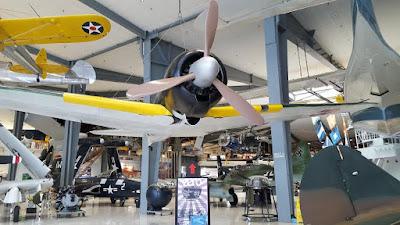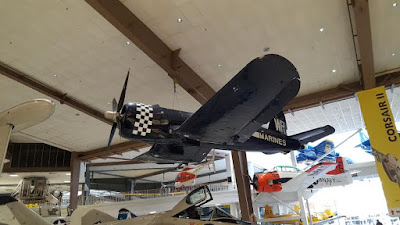This is Part 1
My Son and I went to PNS to visit the Naval Aviation, We last went back in January 2013..
January 2013
Yesterday
It was his idea, he had commented that he would like to go check out
the museum, He had commented that when he went to NOAC last year, they
stopped at the Air Force Museum and he noticed stuff that he missed
several years ago. So we went back to Pensacola. They have changed the
directives for entry..if you don't have a DOD ID card, you have to use
the west gate off Blue Angel Parkway. After showing my drivers license
to the nice guard, he gave me directions to the museum and off we
went. After finding a parking apot, we walked in and the first thing I
saw was a replica of Old NFO Eugene Ely airplane and the historical flight he made when he landed on the U.S.S. Pennsylvania
He then after landing, then turned around and took off again...and Naval Tactics were never the Same.
We then walked into the main room and there were airplanes everywhere.....
And more airplanes....
We walked around and saw more planes...they are grouped by era's of
flight I immediately walked up to an airplane.....I say ..WALKED up to
an airplane..
and
took this picture...This is a P40 in the colors of the Adam and Eve
squadron one of the 3 pursuit squadrons, the other being the Panda Bears
and the Hell Angels. This is what I liked about the museum...with rare
exceptions...you can walk up to the airplane and touch it if you
want. Most museums, you have a rope barrier blocking you.
Training F4F....this is one of the planes they fished out of the lake Michigan during WWII
USS
Wolverine (IX-64) underway in Lake Michigan. Between 1943 and 1945, two
U.S. Navy aircraft carriers stationed at Navy Pier in Chicago
functioned as training platform for about 17,000 pilots, signal officers
and other personnel. The Navy also operated a drone program from one of
the carriers. (Courtesy | National Archives)Pier in Chicago functioned as training platform for about 17,000
pilots, signal officers and other personnel. Former U.S. President
George H. W. Bush was among the pilots who learned to take off and land
on the 500-foot long carrier decks.
U.S.S. Sable docked in Chicago
The Mitsubishi A6M "Zero" is a long-range fighter aircraft, manufactured by Mitsubishi Heavy Industries, and operated by the Imperial Japanese Navy from 1940 to 1945. The A6M was designated as the Mitsubishi Navy Type 0 Carrier Fighter (零式艦上戦闘機 rei-shiki-kanjō-sentōki?), or the Mitsubishi A6M Rei-sen. The A6M was usually referred to by its pilots as the "Reisen" (zero fighter), "0" being the last digit of the Imperial year 2600 (1940) when it entered service with the Imperial Navy. The official Allied reporting name was "Zeke", although the use of the name "Zero" was later commonly adopted by the Allies as well.
When it was introduced early in World War II, the Zero was considered the most capable carrier-based fighter in the world, combining excellent maneuverability and very long range. The Imperial Japanese Navy Air Service ("IJNAS") also frequently used the type as a land-based fighter.
In early combat operations, the Zero gained a legendary reputation as a dogfighter, achieving the outstanding kill ratio of 12 to 1, but by mid-1942 a combination of new tactics and the introduction of better equipment enabled the Allied pilots to engage the Zero on generally equal terms. By 1943, inherent design weaknesses and the failure to develop more powerful aircraft engines meant that the Zero became less effective against newer enemy fighters, which possessed greater firepower, armor, and speed, and approached the Zero's maneuverability. Although the Mitsubishi A6M was outdated by 1944, design delays and production difficulties of newer Japanese aircraft types meant that it continued to serve in a front line role until the end of the war. During the final year of the War in the Pacific, the Zero was also adapted for use in kamikaze operations. During the course of the war, Japan produced more Zeros than any other model of combat aircraft.
The Vought F4U Corsair is an American fighter aircraft that saw service primarily in World War II and the Korean War. Demand for the aircraft soon overwhelmed Vought's manufacturing capability, resulting in production by Goodyear and Brewster: Goodyear-built Corsairs were designated FG and Brewster-built aircraft F3A. From the first prototype delivery to the U.S. Navy in 1940, to final delivery in 1953 to the French, 12,571 F4U Corsairs were manufactured by Vought, in 16 separate models, in the longest production run of any piston-engined fighter in U.S. history (1942–53).
We also saw the 4 A-4's that comprised the Blue Angels..The A-4's served with the Blue Angels for about 10 years.
This was the distance the Blue Angels were separated by in the formation flying, Old NFO mentioned that to me. it shows the skills and balls to fly that close.
Regular A-4 in "Fleet Color"
The Skyhawk is a lightweight aircraft with a maximum takeoff weight of 24,500 pounds (11,100 kg) and has a top speed of more than 670 miles per hour (1,080 km/h). The aircraft's five hardpoints support a variety of missiles, bombs and other munitions. It was capable of carrying a bomb load equivalent to that of a World War II-vintage Boeing B-17 bomber, and could deliver nuclear weapons using a low altitude bombing system and a "loft" delivery technique. The A-4 was originally powered by the Wright J65 turbojet engine; from the A-4E onwards, the Pratt & Whitney J52 was used.
Skyhawks played key roles in the Vietnam War, the Yom Kippur War, and the Falklands War. Sixty years after the aircraft's first flight, some of the nearly 3,000 produced remain in service with several air arms around the world, including from the Brazilian Navy's aircraft carrier, São Paulo.













This comment has been removed by the author.
ReplyDeleteOn the A-4, I remember hearing Cmdr. Paul Galanti speak of it as the last jet combat aircraft that cost less than a million dollars and the last without a computer. They have one at the Virginia Aviation Museum dressed in his livery.
ReplyDeleteThat is really cool. I would like to see that some day.
ReplyDeleteGreat pics! And .45ACP is correct. The A-7 had a computer... but it took 1.4 people to actually USE the entire repertoire of the airplane... The A-4 was designed as a replacement for the AD-1 Skyraider.
ReplyDeleteGreat pics! And .45ACP is correct. The A-7 had a computer... but it took 1.4 people to actually USE the entire repertoire of the airplane... The A-4 was designed as a replacement for the AD-1 Skyraider.
ReplyDelete